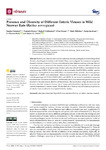Presence and Diversity of Different Enteric Viruses in Wild Norway Rats (Rattus norvegicus)
Niendorf, Sandra
Harms, Dominik
F. Hellendahl, Katja
Heuser, Elisa
Böttcher, Sindy
Jacobsen, Sonja
Bock, Claus-Thomas
Ulrich, Rainer G.
Abstract:
Rodents are common reservoirs for numerous zoonotic pathogens, but knowledge about
diversity of pathogens in rodents is still limited. Here, we investigated the occurrence and genetic
diversity of enteric viruses in 51 Norway rats collected in three different countries in Europe. RNA of
at least one virus was detected in the intestine of 49 of 51 animals. Astrovirus RNA was detected
in 46 animals, mostly of rat astroviruses. Human astrovirus (HAstV-8) RNA was detected in one,
rotavirus group A (RVA) RNA was identified in eleven animals. One RVA RNA could be typed as
rat G3 type. Rat hepatitis E virus (HEV) RNA was detected in five animals. Two entire genome
sequences of ratHEV were determined. Human norovirus RNA was detected in four animals
with the genotypes GI.P4-GI.4, GII.P33-GII.1, and GII.P21. In one animal, a replication competent
coxsackievirus A20 strain was detected. Additionally, RNA of an enterovirus species A strain was
detected in the same animal, albeit in a different tissue. The results show a high detection rate and
diversity of enteric viruses in Norway rats in Europe and indicate their significance as vectors for
zoonotic transmission of enteric viruses. The detailed role of Norway rats and transmission pathways
of enteric viruses needs to be investigated in further studies.
Files in this item

